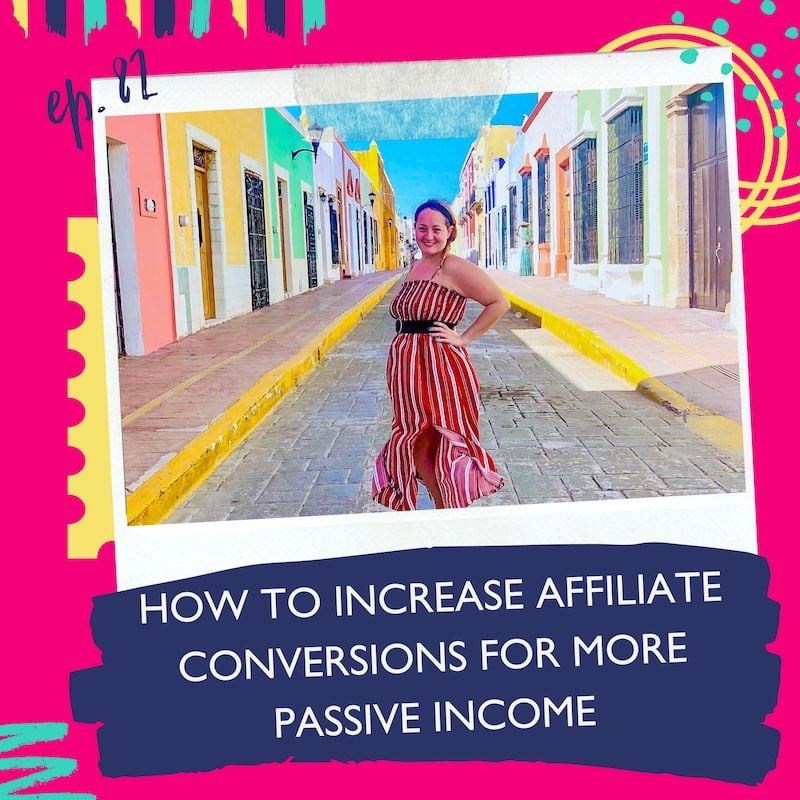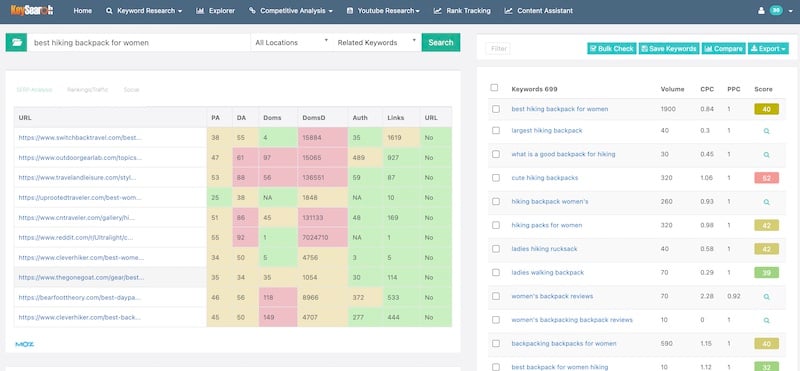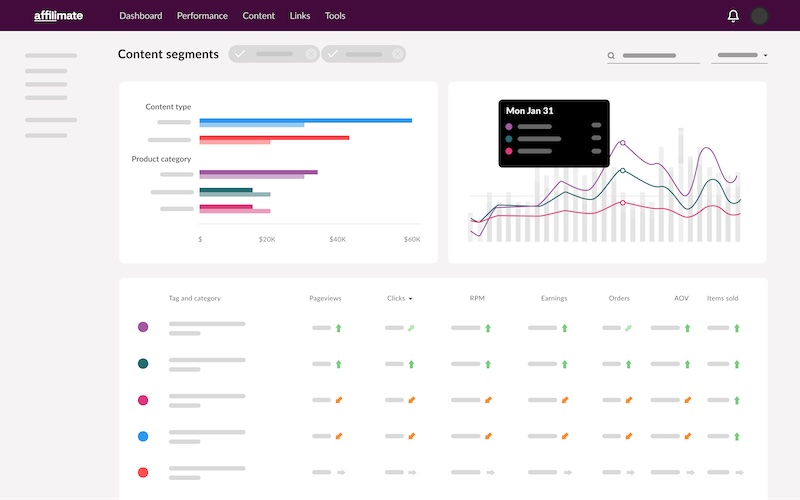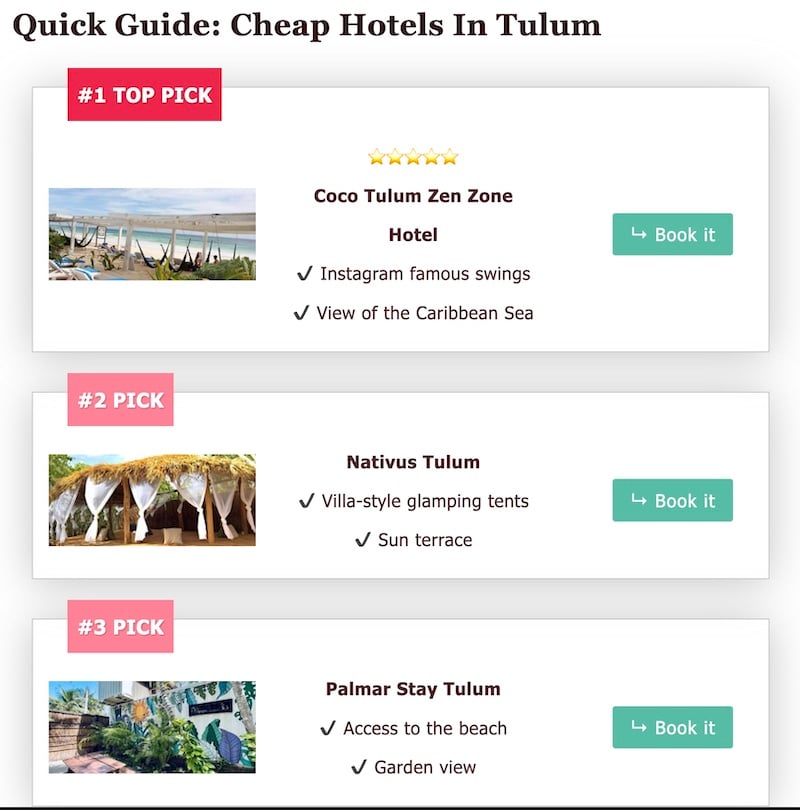How To Increase Affiliate Conversions For More Passive Income [Ep. 82]
By Jessie Festa. This episode on how to increase affiliate sales contains affiliate links to trusted partners I think you’ll love!
Interested in learning how to increase affiliate conversions for more passive income?
Well, you’re in luck, as in this episode of The Profitable Travel Blogger Podcast, we’ll be going over the exact steps you should take if you want to increase your affiliate marketing sales as a blogger!
Our guest for the episode is travel blogger and affiliate marketing expert Shelley Marmor, who will be sharing her best tips. By the end of this episode, you’ll understand:
- How to increase your affiliate sales through strategic content creation
- The key to writing blog posts that attract people looking to make a purchase
- Ideas for how to update your already-existing blog posts to give them an affiliate income boost
- How to track affiliate conversions and test the effectiveness of your affiliate content updates
- And more!
In short, if you’re confused by affiliate marketing or are sick of adding affiliate links to your posts without getting clicks, this episode can help.
How To Increase Affiliate Conversions [Podcast Episode Audio]
Click here to listen on Apple Podcasts/iTunes
Click here to listen on Spotify
Click here to listen on Amazon Music
Click here to listen on TuneIn
Free Travel Blogger Resource Library
To help you really jumpstart your blogging success, I’ve added 55+ blogging resources like printables, video tutorials, and workbooks into a FREE resource library for travel bloggers.
These resources are meant to help you grow your traffic, community, and income faster and with less overwhelm!
Increase Your Affiliate Sales With These Helpful Tools:
Affiliate Tables. After becoming frustrated by a lack of options for high-converting comparison tables, Shelley created her own. Simply adding these boxes to her blog and including affiliate links led to a major increase in affiliate sales!
TablePress. This free plugin allows you to create simple comparison tables, which can help increase affiliate link clicks as you can help readers quickly and easily compare their options.
Affiliate Marketing 101 Masterclass for Travel Bloggers. In this 90-minute masterclass, Shelley shows you exactly how she’s grown her blogging income to multiple six figures thanks to affiliate marketing. If you’re new to affiliate marketing or are struggling to actually make money from it, this masterclass is for you.
How To Find Affiliate Marketing Keywords Course. Want to go in-depth on how to create a profitable content plan optimized to make affiliate sales? In this course, Shelley will teach you exactly how to find lucrative affiliate keywords that you can rank for fast and make lots of money from.
Affiliate Blog Post Template. In this guide, you’ll learn exactly how Shelley creates and formats high-converting affiliate posts that earn her passive income while she sleeps.

Affilimate. If you’re serious about increasing your affiliate conversions, this premium platform provides tools and analytics to track conversions, understand user behavior, and improve the performance of affiliate content.
Keysearch (snag 30% off with code “jessieonajourney30”). When trying to optimize your affiliate posts to rank in Google, Keysearch can help you do your important keyword research. This budget-friendly yet robust tool helps me consistently rank my content at the top of organic search results!
Spectra. This is one of many plugins that can add enhanced functionality to your Gutenberg Blocks in WordPress. For instance, it allows you to add star ratings to your hotel blurbs, which can lead to a boost in affiliate sales as it acts as social proof.

How To Increase Your Affiliate Sales [Episode Transcript]
The following is a summary of the podcast episode sharing affiliate marketing tips for travel bloggers. It is transcribed as best as possible, with paraphrasing included. For the full strategy on how to increase affiliate conversions, make sure to listen to the audio version of the podcast above.
Have you ever created content with a goal of increasing your affiliate income, but then barely saw any clicks? Or maybe you’re new to the world of affiliate marketing for travel bloggers and want to know how to actually get people to take action on your affiliate links?
If you’re nodding along, then this episode is for you. Our guest, Shelley Marmor from the sites Travel Mexico Solo and Travel Blogging 101, has been able to grow her blogging income to multiple six figures thanks to affiliate marketing.
In fact, she was able to reach this level of success in only her second year of blogging – with no previous blogging experience.
Today, she’s going to be sharing her best tips for how you can give your content an affiliate boost, increase your conversions, and grow your passive income.
Free travel blogger resource library
But first, before we go over how to increase your affiliate conversions, I want to share my free Travel Blogger Resource Library.
Inside you’ll snag access to 55+ resources from cheat sheets to workbooks to workshops to video tutorials that can help truly turn your blog into a profitable business – including a Crafting Profitable Affiliate Posts Workbook.
I’m all about implementation and I really want to make sure you don’t just listen to the episode and forget about it, but that you actually use what I share to make your blogging life easier. Feel free to even pause this episode to go grab those resources.
You back? Then let’s dive into how to increase affiliate sales.
What Is A Good Conversion Rate For Affiliate Marketing?
Let’s begin by going over affiliate conversion rates. While what is seen as a good affiliate conversion rate varies by industry and program, in general:
- Low = less than 1%
- Average = 1%-5%
- High=over 5%
- Outstanding=10% or higher
Keep in mind, there are many things that can impact affiliate marketing conversions, like:
Traffic quality: High-quality, targeted traffic is more likely to convert. You’ll want to target keywords and audiences closely related to the product or service you’re promoting.
Blog post optimization: A strategically formatted blog post that appeals to your target audience, provides clear information, and has a strong call to action can significantly increase conversions.

Offer relevance: The more relevant the offer is to your audience, the higher the likelihood of conversion.
Trust: Building trust with your audience through content that shows you are genuine and that you’re an expert on your topic can also improve affiliate program conversion rates.
Testing and optimization: Continuous A/B testing and optimization based on data can help in understanding what works and what doesn’t. Then, when you see something works to increase your affiliate marketing conversion rate, do more of that!
On that note, let’s dive into the episode on how to increase affiliate conversions.
1) Thank you so much for taking the time to share your affiliate marketing tips! To start, can you tell us more about yourself, your blog, and how you got into affiliate marketing?
I started my travel blog in April 2020. It was an unusual beginning as travel bloggers weren’t traveling, yet, it provided an unforeseen advantage – the community was more accessible and more willing to hop on Zoom calls with a newbie blogger.
I got introduced to affiliate marketing when I discovered that despite the travel standstill, some bloggers were still earning, particularly through Airbnb’s affiliate program.
Although this program no longer exists, it served as my entry point into affiliate marketing. By January 2021, nine months into blogging, I earned my first affiliate income of $77.10 through the Airbnb affiliate program.

Identifying affiliate marketing’s potential, I relentlessly focused on scaling what worked. By continuously amplifying my affiliate marketing efforts, I closed out 2022 with about $275,000 in earnings, just in my second year of blogging.
Then in 2023, I made $234,081 from affiliate marketing alone in the first 6 months.
Along the way, I’ve learned the importance of adapting my strategy and doubling down on successful affiliate marketing strategies.
2) When you were learning how to do affiliate marketing, what would you say is the #1 thing that helped you start actually making money with this revenue stream?
One significant realization that propelled my affiliate marketing success was understanding “Buyer Intent or “User Intent”.
It’s a concept that revolves around the notion that the keywords people use in search engines reveal their underlying intentions.
For instance, there’s a stark difference in intent between someone searching for the “best time to visit Paris” versus “best hotels in Paris”.
- A searcher looking up the best time to visit Paris is likely in the information-gathering phase and not yet ready to make purchases.
- On the flip side, someone inquiring about the best hotels in Paris exhibits a stronger intent to make a booking.

Recognizing these nuances in search behavior is crucial.
Many beginner bloggers fall into the trap of embedding affiliate links in posts that cater to informational intent, like suggesting hotels or tours in a post about the best time to visit Paris.
While this might result in sporadic sales, it doesn’t align with the visitor’s immediate intent, so this type of content won’t be what brings you steady passive income.
3) Let’s talk about auditing existing content for affiliate marketing improvements. What is the #1 thing you see holding bloggers back from really increasing their affiliate revenue?
User intent: One recurrent hiccup that I notice while auditing bloggers’ content is a misalignment between their content and the user’s intent, which will likely affect their affiliate revenue significantly.
Affiliate link visibility: However, a more immediate and often overlooked obstacle is the visibility of affiliate links within the content.
While working one-on-one with bloggers over the past year, I’ve conducted numerous post audits, and a startling revelation has been the invisibility of affiliate links due to poor color contrast or indistinct formatting. One example of this would be black text paired with navy blue links, rendering the link almost invisible.
This simple oversight leaves potential commissions on the table, as readers can’t click on what they can’t see. Luckily, this is simply to fix as you can tweak your link colors in your blog’s design settings.
A few recommendations for things to add to your blog posts:
Contrasting colors: Choose a link color that stands out against the background and surrounding text. If your text is black, contrasting colors like red or bright blue can make the link pop.
Underlining links: If you prefer sticking to a specific color palette aligning with your brand, ensure your links are underlined. This simple formatting cue signifies to readers that the text is clickable.
Action-oriented phrasing: Incorporate action verbs in your link text to guide readers on what to do next. Instead of just linking the hotel name, phrase it as “book [hotel name].” This not only makes the link’s purpose clear but also nudges the reader towards taking the desired action.

4) Let’s say we’ve written a blog post and it’s optimized for a buyer-intent keyword like “best hotels for families in NYC”. Beyond optimizing the post for SEO to rank in search, what are some things we could do to increase affiliate conversions on that post?
Creating a blog post optimized for buyer-intent keywords is just one piece of the puzzle. To truly maximize conversions, especially in a competitive domain like affiliate marketing for hotels, you’ll want to get more strategic.
A few affiliate marketing tips for this:
Use conspicuous affiliate links: Ensure your affiliate links are conspicuous with contrasting colors or underlining to make them stand out.
Deep dive into secondary keywords: Initial keyword research might lead you to high-competition keywords dominated by industry leaders like Booking.com or TripAdvisor. It’s crucial to delve into secondary or long-tail keywords that could provide an easier path to ranking while still aligning with user intent.
Utilize keyword research tools & include supporting keywords: Utilizing tools like Keysearch (30% off with code “jessieonajourney30”) can unearth a plethora of secondary keywords related to your primary keyword. Remember, it isn’t just your main keyword that you want to bring you blog traffic, but also secondary keywords.
For example, if writing about “hotels for families in NYC” other keywords to include might be “New York hotels for families” and “family friendly hotels in NY”.
Additionally, incorporating supporting keywords into your content can signal to search engines the comprehensiveness and relevance of your post.

Encourage action: Adopt action-oriented verbiage within your affiliate links or around them, guiding readers towards making a booking or further exploring the options provided.
Create a great user experience: Create an inviting, easy-to-navigate post with well-structured content, compelling images, and perhaps even a comparison table of the hotels discussed (if creating a hotel post). You want to make sure the content is factual, in-depth, and easy to read.
Include social proof and reviews: Integrate reviews, testimonials, or social proof visuals like star ratings to bolster the credibility of your recommendations.
Track, analyze, and optimize: Utilize affiliate conversion tracks and analytics to track the performance of your affiliate links. Understand which strategies are driving conversions and optimize your post accordingly over time.
5) When it comes to making links stand out, have you found that a certain style of visual works better than another? For instance, does having photos in the affiliate box matter? Emojis? Comparison boxes? Star ratings? Something else?
Visual elements are effective in grabbing attention quickly and can help improve the click-through rate (CTR) on affiliate links. The impact of different visual cues can change based on the site context or its niche.
Here’s a simplified breakdown:
Deep links: These in-text links are often seen as effective converters due to their simplicity and non-disruptive nature. They blend well with the content, providing a straightforward option for readers interested in learning more.
Emojis: Emojis add a casual, relatable touch to the content, drawing attention to key points, although their effectiveness may vary across different niches.

Images: Images give a visual idea of the promoted product or service, and are especially effective in visually-driven niches like travel.
Comparison boxes: These boxes are great for comparing similar products or services, helping readers make informed decisions quickly.
Star ratings: They provide a quick glimpse of product quality and user satisfaction, aiding in decision-making, especially given their common use on platforms like Amazon.
You can try a variety of visual elements for increase your affiliate sales, then analyze the data to understand what works for your audience and optimize accordingly in a cycle of continuous improvement.
Important note: Just make sure to maintain a balance between engaging visuals and simple deep links to avoid overwhelming or distracting the readers.
6) Another way to share affiliate links is by adding information boxes underneath the introduction of the blog post. Can you share more information on how this works and why it’s an effective affiliate strategy?
Placing valuable information upfront can significantly enhance user experience and affiliate conversions. While some people will want to read your entire blog post, others just want the quick facts and recommendations.
Incorporating affiliate links in information boxes right after the blog post introduction is a strategy that has proven to be effective and lucrative.

Here why:
It offers an immediate value proposition: Presenting the highlights of an itinerary (like hotels and tours), top picks from a round-up (such as favorite hotels), or a quick recommendation (with an affiliate link) instantly caters to the readers’ primary needs without making them sift through paragraphs.
This tactic addresses the common problem of information overload, making the process less overwhelming for the reader.
It offers social proof: Highlighting top picks based on specific criteria, like budget-friendly or family-friendly, provides social proof and makes the choice easier for readers.
It shows an understanding of user intent: It’s crucial to understand what the user is looking for. If they’re in a buying mindset, burying useful information deep within the text can be frustrating and counterproductive.
By understanding and addressing the pain points of the target audience, like the need for free babysitting services in a hotel, affiliate marketers can provide valuable solutions upfront.
There’s often a fear of appearing too “salesy”, but when you provide valuable information to users genuinely looking to make a purchase, it’s a service rather than a hard sell.
7) Another way to visually share affiliate links is through widgets, which many affiliate programs provide their publishers. What are your thoughts on using widgets to increase affiliate conversions? Any tips?
Widgets from affiliate programs can present affiliate links in an attractive way, bundling recommendations with images, prices, and unique selling points; however, they may not always help achieve the desired conversion rates.
Here’s why and how one could optimize their use:
Ad blindness is an issue: Widgets might be seen as ads, which many internet users tend to ignore due to “ad blindness”. This can reduce the effectiveness of widgets in driving affiliate conversions.
Analyze conversion data: It’s important to use analytics to understand where conversions are coming from. This information can guide decisions regarding the use of widgets or other affiliate marketing tools.

Customize affiliate widgets for relevance: Platforms like Viator, which is often a high-converting affiliate program for travel bloggers, allow you to select which tours appear in the widget, making the content more relevant to the blog post.
Test and optimize: The effectiveness of widgets can differ based on the site and audience, so testing them in different settings and monitoring their performance is smart. This way, publishers can determine if widgets fit well with their affiliate strategy and audience behavior.
Alternatives to widgets: Considering the possible downside of widgets, it might be worth looking into other methods like deep links, information boxes, or creating a custom section with affiliate links for better results.
8) I know you use a tool to track your affiliate income as well as if updates you make to your blog posts actually lead to affiliate conversions. Can you talk about this?
The tool is called Affilimate. I call it the “Google Analytics of affiliate marketing” as it gives you so much data.
While Affilimate is not cheap and is definitely an investment, most affiliate marketing programs fall short when providing these deep insights, so it can be very necessary for those looking to get serious about affiliate marketing.

Some noteworthy features include:
Heat maps: The heat maps feature shows user interactions on my pages, indicating what catches my audience’s attention.
Conversion tracking: More than just tracking clicks, Affilimate tracks conversions to help me understand what motivates users to take desired actions, revealing the effectiveness of my affiliate links.
A repeatable strategy for affiliate marketing success: By mapping every click and conversion, I understand what strategies work, allowing me to replicate successful methods.
9) Many bloggers, while great storytellers, struggle with the design. Do you have any favorite plugins or tools that can make creating these sort of affiliate boxes, tables, and visuals easier?
Jessie: I’ve personally used the free TablePress plugin before to create comparison charts, simple Gutenberg blocks to create info boxes with colored backgrounds, and Spectra to add enhanced Gutenberg block features like adding star ratings to hotel listings, but I’d love to hear your suggestions.
Shelley: I actually ended up creating my own, though I did test out a few first.
My first stop was AmaLink, a widely recognized plugin; however, it soon became apparent that it was restrictive, allowing only Amazon products.
After a further search, I invested in a premium plugin that promised functionality beyond Amazon affiliate marketing; however, the experience was disheartening.
Despite its high cost, the plugin was not mobile-responsive. The ensuing conversation with the developer was disappointing, as the only solution they gave was for me to stop lazyloading my images – which would be terrible for site speed and SEO.
To overcome this hurdle, I dedicated a few hours to creating what I now call my “Affiliate Tables” – which I also sell. They are mobile-responsive, neatly designed, and can really help increase your affiliate clicks.
The payoff of adding these to my blog was almost immediate. I integrated my new tool at the top of my posts, and it resonated with my audience. It became a source for approximately 50% of my affiliate conversions!

10) For bloggers wanting to update their content to increase affiliate conversions, how do you recommend they choose which blog posts to update?
Embrace the 80/20 rule: Something important to understand when updating content to increase your affiliate conversions is the likelihood that 20% of your posts bring in 80% of the traffic.
These high-performing posts are your most important pieces of content when it comes to passive income, and their health significantly impacts your affiliate conversion rate.
If any of these posts experience a drop in rankings, you should work to update them immediately.

Consider seasonality: Consumer interest often changes with the seasons, and it’s smart to update your posts accordingly.
By preparing for the next season a few months in advance, you give Google enough time to recognize your updates, which can help improve your rankings right before the seasonal traffic spike.
Review your analytics monthly. Set aside time each month to audit your most popular blog posts for potential affiliate marketing improvements. For instance, some posts might:
- be missing affiliate links,
- need the affiliate links to stand out more,
- be missing a call-out box underneath the introduction,
- etc.
11) What are the biggest mistakes you see bloggers who are trying to increase their affiliate income make?
To improve affiliate conversions, a few common mistakes to avoid include:
Random link insertion: Placing links randomly in posts without a strategy won’t help you increase your recurring passive income.
The key is to match the reader’s needs with solutions through affiliate links. When this doesn’t happen, readers leave and potential affiliate income is lost.

Misunderstanding reader intent: For instance, if you share a guide on solo travel in Italy and include a link to a backpack, the connection is weak.
Readers came for travel tips, not backpack recommendations, reducing the chance of affiliate conversions.
Not targeting ready-to-buy readers: Knowing the difference between casual browsers and ready-to-buy readers is vital.
A post titled “best backpacks for solo travel” attracts readers ready to purchase, unlike a vague backpack mention in a travel guide.
12) Thank you so much for sharing your wisdom! Before we sign off, can you let everyone know where they can find you?
- Travel Mexico Solo (travel blog)
- Blogging 101 (blogging website)
- 5 Best Affiliate Programs For Travel Bloggers (free guide)
Alright, now I hope you enjoyed this episode. I hope you feel inspired and empowered to increase your affiliate conversions and boost your passive income.
Before you go, don’t forget to grab access to the free Travel Blogger Resource Library. There are a ton of resources in there on growing your community and increasing your blogging profits.
And of course, make sure to subscribe so you don’t miss future episodes sharing these bite-sized strategies for bloggers who want to turn their blogs into profitable full-time businesses.
Happy blogging!
Increase Your Affiliate Conversions With These Helpful Past Episodes:
How To Increase Your Amazon Affiliate Income As A Travel Blogger
How To See Success With Affiliate Marketing For Travel Bloggers
15 Creative Ways To Promote Affiliate Links As A Blogger
How To Create A Resources Page That Grows Your Affiliate Income
How To Use White Label Affiliate Programs To Monetize Your Blog
How Niching Down Can Help You Grow & Monetize Your Blog
How To Find Niche Keywords By Doing Competitor Research
How To Reach Your Blogging Goals Faster With Outreach Days
How To Update Website Content For Increased Traffic
How To Plan Out A Year Of Content In One Week
Click here for all profitable blogging podcast episodes.
Connect With The Profitable Travel Blogger Podcast
Stay In The Loop
Do you want to get notified when new episodes publish?
Then make sure to opt-in for podcast email notifications sent to your inbox!
You can do that by clicking here.
Subscribe + Review (To Win A Prize!)
Love learning new blogging strategies to help grow your website traffic, community, and income?
Click here to subscribe on iTunes to be notified when new episodes publish.
I’d also be extremely grateful if you’d leave a review right here and let me know your favorite part of the episode or a takeaway you walked away with. By leaving a review, you help the show be seen by more people, helping the episodes to have a greater impact.
Bonus:
Each month, I’ll be choosing one reviewer at random to win a FREE seat inside one of my masterclasses.
Winners can choose from:
- How To Grow Your Blogging Income Through Facebook Ads
- How To Land Paid Press Trips As A Travel Blogger
- How To Make Money (Fast) With Affiliate Marketing
- How To Start A Tour Company In Your Own Backyard
- How To Start A Blog, Grow An Audience & Make Money
- Build Your Blogging Profit Plan Masterclass
Winners will be chosen at random from the reviews and will be notified via email, so make sure to send me — jessie (at) jessieonajourney dot) com — your email address so I have it.

